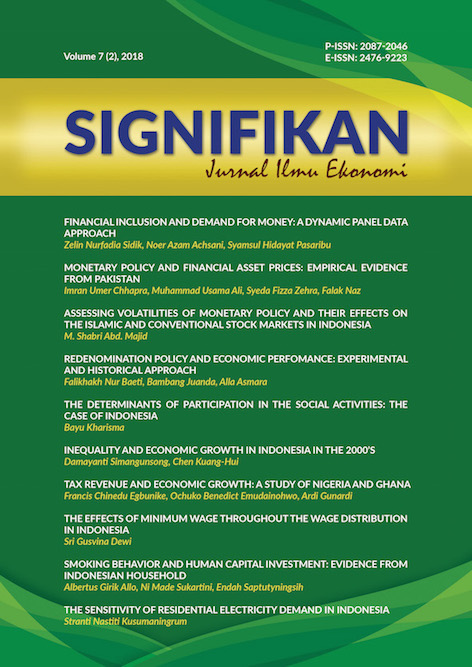Financial Inclusion and Demand for Money: a Dynamic Panel Data Approach
DOI:
https://doi.org/10.15408/sjie.v7i2.6838Keywords:
financial inclusion, demand for money, dynamic panel dataAbstract
Financial inclusion is designed to increase the opportunities and society participation in the formal financial institution, especially for unbanked people. Moreover, financial inclusion is one of strategy inclusive economic growth. However, financial inclusion may lead an ineffectiveness of monetary policy. It is because financial inclusion can affect the sensitivity of interest rate, and it could cause instability demand for money. Therefore, the research aims to analyze the impact of financial inclusion on demand for money, reserve money (M0), in 36 countries for the period 2004 to 2014. The method that used is Dynamic Panel Approach. The result shows that financial inclusion stimulates the increase of demand for reserve money (M0) in developed countries. In the other hand, the increasing of financial inclusion could decrease the demand for reserve money (M0) in developing countries.
References
Achsani, N. A. (2010). Stability of Money Demand in an Emerging Market Economy: an Error Correction and ARDL model for Indonesia. Research Journal of International Studies. Vol. 13: 54-62.
Attanasio, O. P., Guiso, L., & Jappelli T. (2002). The Demand for Money, Financial Innovation, and The Welfare Cost of Inflation: An Analysis With Household Data. Journal of Political Economy. Vol. 110(2): 317-351. doi: https://doi.org/10.1086/338743.
Baltagi, B. H. (2005). Econometric Analysis of Panel Data (3rd Ed). Chichester UK: John Wiley & Sons, Ltd.
Columba, F. (2009). Narrow Money and Transaction Technology: New Disaggregated Evidence. Munich Personal RePec Archive (MPRA) Paper. 12689.
Dasril, R. O. (2017). Dampak Inklusi Keuangan Terhadap Permintaan Uang (The Impact of Financial Inclusion to Demand of Money). (Unpublished Thesis). Bogor: Bogor Agricultural University.
Demirgüc-Kunt, A., & Klapper, L. F. (2012). Measuring Financial Inclusion: The Global findex database. Policy Research Working Paper. World Bank. 6025:1-58.
Dienillah, A. A., & Anggraeni, L. (2016). Dampak Inklusi Keuangan Terhadap Stabilitas Sistem Keuangan di Asia (The Impact of Financial Inclusion on Financial System Stability in Asia). Buletin Ekonomi Moneter dan Perbankan. Vol. 18(4): 409-430.
Dunne, J. P., & Kasekende, E. (2016). Financial Innovation and Money Demand: Evidence From Sub-Saharan Africa. Economic Research Southern Africa (ERSA) Working Paper. 583.
Firdaus, M. (2011). Aplikasi Ekonometrika untuk Data Panel dan Time Series (Econometric Application for Panel Data and Time Series). Bogor: IPB Press.
Hafer, R. W., & Kutan, A. M. (2010). Financial Innovation and The Demand for Money: Evidence From The Philippines. International Economic Journal. Vol. 17(1): 17-27. doi: https://doi.org/10.1080/10168730300080002.
Khan, H. R. (2011). Financial Inclusion and Financial Stability: Are They Two Sides of The Same Coin? Retrieved from: https://www.bis.org/review/r111229f.pdf.
Lucas, R. E. (2000). Inflation and Welfare. Econometrica. Vol. 68(2): 247-274. doi: https://doi.org/10.1111/1468-0262.00109.
Mehrotra, A., & Yetman, J. (2015). Financial Inclusion-Issue for Cental Banks. BIS Quartely review, Bank for International Settlements. 83-96.
Sanjaya, I. M., & Nursechafia. (2016). Inklusi Keuangan dan Pertumbuhan Inklusif: Analisis Antar provinsi di Indonesia (Financial Inclusion and Inclusive Growth: Cross-Province Analysis in Indonesia). Buletin Ekonomi Moneter dan Perbankan. Vol. 18(3): 281-306.
Sarma, M. (2008). Index of Financial Inclusion. Indian Council for Research on International Economic Relations Working Paper. 215:1-20.
Sarma, M. (2012). Index of Financial Inclusion – A Measure of Financial Sector Inclusiveness. Berlin Working Papers on Money, Finance, Trade, and Development. 07:1-37.
Sichei, M. M., & Kamau, A. W. (2012). Demand for Money: Implications For The Conduct of Monetary Policy in Kenya. International Journal of Economics and Finance. Vol. 4(8): 72-82. doi: https://doi.org/10.5539/ijef.v4n8p72.

